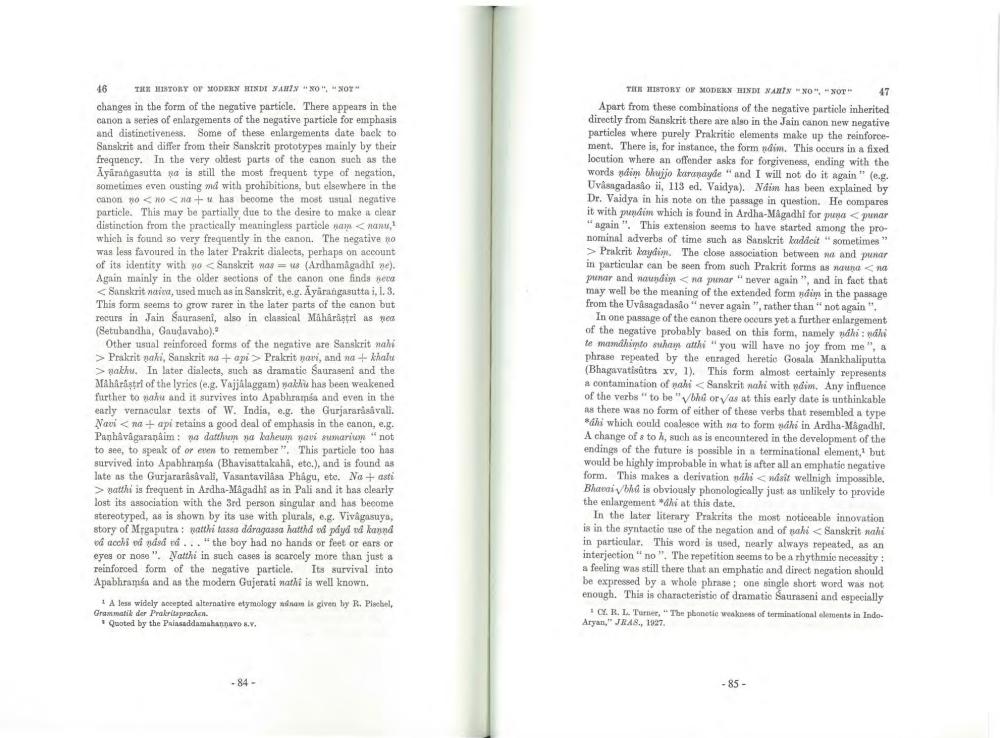________________
46 TAR HISTORY OF MODERN HINDI ANTYKO OT changes in the form of the negative particle. There appears in the canon a series of enlargements of the negative particle for emphasis and distinctiveness. Some of these enlargements date back to Sanskrit and differ from their Sanskrit prototypes mainly by their frequency. In the very oldest parts of the canon such as the Ayamngasutta pa is still the most frequent type of negation, sometimes even ousting md with prohibitions, but elsewhere in the canon 90 <NO + # has become the most ustal negative particle. This may be partially due to the desire to make clear distinction from the practically meaningless particle nan <nan, which is found so very frequently in the canon. The negative no was less favoured in the later Prakrit dialects, perhaps on account of its identity with < Sanskrit was = * (Ardhamagadhi ne). Again mainly in the older sections of the canon one finds here <Sanskrit , sed much as in Sanskrit, e.g. Ayarangasutta i, 1. 3. This form seems to grow rarer in the later parts of the canon but recurs in Jain Sauraseni, also in classical Maharaştri as pes (Setubandha, Gaudavabo).
Other usual reinforced forms of the negative are Sanskrit nahi > Prakrit naki, Sanskrit wo + api > Prakrit maur, and makhalte > Bathu. In later dialects, such as dramatic Sauraseni and the Maharastri of the lyrics (eg. Vajjalaggam) akhte has been weakened further to make and it survives into Apabhruins and even in the early vernacular texts of W. India, e.g. the Gurjararásávali. Navi <me + api retains a good deal of emphasis in the canon, e.g. Panhåvågaranåim: we datthema kahew wave smart not to see, to speak of or even to remember". This particle too has survived into Apabhrama (Bhavisa talahi, etc.), and is found as late as the Gurjararásávali, Vasantavilasa Phagu, etc. Na + aste > natthi is frequent in Ardha-Mågadhi as in Pali and it has clearly lost its association with the 3rd person singular and has become stereotyped, as is shown by its use with plurals, e.g. Vivagasuya, story of Mrgaputra: watthisse daragaasa hatthd vd payd kannd o acchi ni yasa d... "the boy had no hands or feet or ears or eyes or nose". Natthi in such cases is scarcely more than just a reinforced form of the negative particle. Its survival into Apabhrama and as the modern Gujerati nathi is well known.
TIL STORY OF MODERN HINDI NANIN XOXOT 47 Apart from these combinations of the negative particle inherited directly from Sanskrit there are also in the Jain canon new negative particles where purely Prakritie elements make up the reinforcement. There is, for instance, the form dim. This occurs in a fixed locution where an offender asks for forgiveness, ending with the words adim bhujjo kernayde and I will not do it again" (e.g. Uvas gadasio i113 ed. Vaidya). Naim has been explained by Dr. Vaidya in his note on the passage in question. He compares it with punin which is found in Ardha-Magadhi for pu p unar "agnin". This extension seems to have started among the pronominal adverbs of time such as Sanskrit Kudacit "sometimes" > Prakrit kayfi. The close association between m and punar in particular can be seen from such Prakrit forms as w e <na punar and soundm <n punar "never again, and in fact that may well be the meaning of the extended form dom in the passage from the Uvasagadasito" never again, rather than "not again"
In one passage of the canon there occurs yet a further enlargement of the negative probably based on this form, namely dhi: wiki te m ihimo suhaw at you will have no joy from me", a phrase repeated by the enraged heretic Gosal Mankhaliputta (Bhagavatisútra xv, 1). This form almost certainly represents a contamination of wahi < Sanskrit nahi with dim. Any influence of the verbs "to be" oras at this early date is unthinkable as there was no form of either of these verbs that resembled a type shs which could coalesce with na to form w in Ardha-Magadhl. A change of a to , such as is encountered in the development of the endings of the future is possible in a terminational element, but would be highly improbable in what is after all an emphatio negative form. This makes a derivation wiki wisit wellnigh impossible. Bha b hd is obviously phonologically just as unlikely to provide the enlargement Ghi at this date.
In the later literary Prakrits the most noticeable innovation is in the syntactionise of the negation and of nahi < Sanskrit nahi in particular. This word is used, nearly always repeated, as an interjection "no". The repetition seems to be a rhythmie necessity : a feeling was still there that an emphatic and direct negation should be expressed by a whole phrase one single short word was not enough. This is characteristic of dramatio Sauraseni and especially
1 CYR. L. Turner, "The phonetic weakness of terminational elements in IndoAryan," JR.48., 1927.
in
a given by R. Piebal,
A less widely accepted alternative etymology Grammatik der Prakpaprachan.
Quoted by the Prinseddamannavos..
-85




